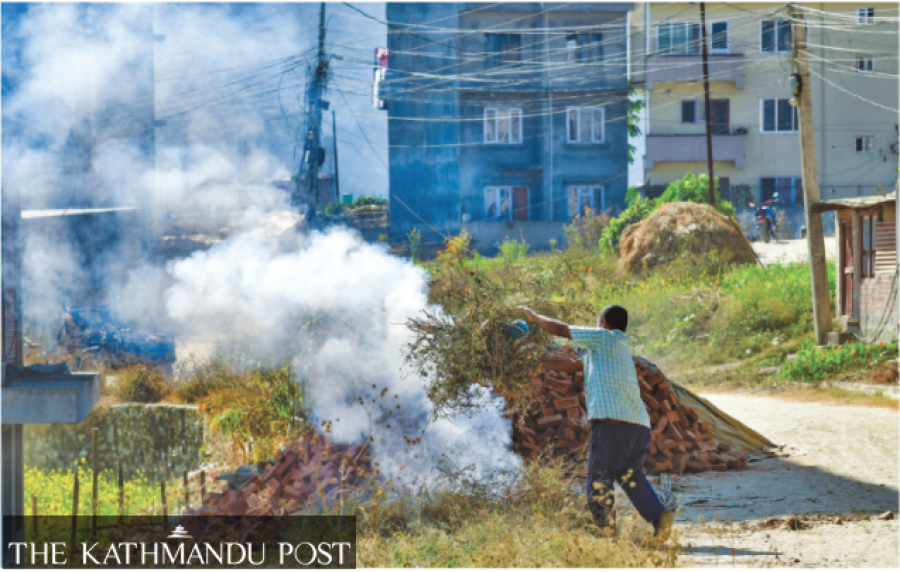Climate & Environment
Open waste burning rife across country for lack of management mechanisms
Little has been done to stop persistent organic pollutants reaching air, which are hazardous to life and environment.
Aakriti Ghimire
Every evening at around 5, local shopkeepers burn solid waste—plastics, paper, cardboard—in Simikot, Humla.
“The shopkeepers burn the waste they collect throughout the day in front of their shops. There’s no waste management policy in Simikot, so the only way people get rid of it is either dumping it or burning it,” says Kritagya Kriti, 21, a volunteer at Himalayan Education And Development (HEAD Nepal), a non-profit organisation that works for persons with disabilities in Simikot.
A similar scene is observed in Myagde Rural Municipality, Tanahun. In addition to daily residential waste, medical wastes are also incinerated in villages.
“Incineration is the only mechanism of solid waste management here. What’s even more worrying is that medical waste from the local health post is being burnt too. The municipality does not collect waste. Nor are there any public dustbins to begin with,” says Saurav Lamichhane, 21, who works in rural education.
Solid waste management, across Nepal, is a major health and environmental concern. The crisis that the urban centres were facing for years now has reached rural areas too.
In villages and outskirts of towns, where there are no waste collection mechanisms, people have no option other than to burn solid waste, including medical waste.
Many municipalities collect solid waste only to incinerate it at collection centres, without realising those burning plastics emit hazardous chemicals and carcinogenic particles.
“Ever since I gave birth, there has been a lot of non-recyclable plastic waste, such as diapers, food packaging plastics, and whatnot. It was a little difficult for us to burn it all in our backyard as we did previously, that is why we started giving the waste to the waste collectors,” said Sarmila Subedi, a homemaker from Ramdhuni Municipality, Sunsari who migrated to Kathmandu five months ago. “But ultimately, they too burn it on the river banks.”
Research demonstrates that open burning is more frequent where waste collection services are sparse, expensive, and unavailable. The study presents that due to the lower waste collection frequency, or efficiency for that matter, in sub-urban areas compared to the municipality core, solid waste is burnt more in such areas.
However, even in the Kathmandu Metropolitan City, which has 77 organisations to collect waste across the city, open-air burning is rampant—at homes, collection centres or incinerators.
Nepal Waste Map, a digital platform that allows citizens to report waste burning, dumping and irregular or untimely waste collection services, records 70 waste burning spots in Kathmandu alone.
Sustainability experts argue that open-air burning is also fuelled by the notion that burning is the easy way to get rid of waste, thereby maintaining sanitation.
This perception is misinformed and hazardous to humans and the environment, experts say.
“People fail to realise that by burning waste, you are simply transporting the waste from the land to the air we breathe, which will ultimately affect our health,” said Shilshila Acharya, director at Avni Ventures, a waste management company.
Not just the public, even the policymakers, and decision-makers hold the same perception towards waste management that affects the waste collection mechanisms employed at various levels of government.
“Having worked with a lot of decision-makers at this point, most of them just want a quick fix; a way to make waste disappear in a snap. And a solution that they see is incinerating it,” said Acharya. “Officials invite foreign nations such as China, Japan, Korea, Finland to install incinerators across Nepal. They take so much pride in these installations that cost millions of dollars and have fancy names without understanding the harmful gases such burning machines emit.”
Incinerators are known emitters of persistent organic pollutants (POPs), toxic chemicals that adversely affect human health and the environment.
Experts say that incineration might take the waste out of sight but the consequences are long-term and insidious. POPs released on burning can be transported over long distances by air and can be bioaccumulated through terrestrial and aquatic food webs, which can adversely impact human and animal health. They also have toxic effects such as immunotoxicity, neurotoxicity, developmental toxicity, carcinogenicity, mutagenicity, and endocrine disruption.
Nepal is a signatory to the Stockholm Convention on Persistent Organic Pollutants since 2007 and has pledged to eliminate the emission and usage of various chemicals such as polychlorinated dibenzo-p-dioxins (PCDD) and polychlorinated dibenzofurans (PCDF).
“Even the most advanced of incinerators will release dioxins and furans, and these are known carcinogens and persistent organic pollutants. As a signatory to the Stockholm Convention, Nepal is in violation of the convention by allowing the operation of more than 100 incinerators all across Nepal,” said Ram Charitra Sah, executive director of Center for Public Health and Environmental Development (CEPHED).
There is no data on the total number of incinerators operational in Nepal, according to Indu Bikram Joshi, a spokesperson for the Department of Environment.
“Hospitals and municipalities have installed incinerators at their own capacities, but we do not have any data. For an incinerator to be approved, there are criteria that have to be met as outlined in the guidelines,” said Joshi referring to the Health Care Waste Management Guidelines (2014).
The department, however, does not have mechanisms to monitor the incinerators and their emissions.
“We can only check the temperature as of now. If the temperature is above 1,100 degrees Celsius, it doesn’t emit persistent organic pollutants, but there is no means to directly monitor the emissions from the incinerators,” said Joshi.
A study conducted by CEPHED and International Pollutants Elimination Network (IPEN) found that most healthcare institutions either openly burn or dump medical waste.
In addition, the ash from incinerators is washed into the rivers or thrown into municipal mixed waste containers. A lack of regulatory standards for incinerators or alternative measures and adequate awareness of the problem was discovered by the study.
Not just incinerators but the burning of solid wastes at household levels also emits POPs and carcinogenic materials.
“Burning of daily household usage of plastics and medical wastes is extremely dangerous. Soft plastics such as surgical gloves, blood bags, tubes, biscuit wrappers and plastic bags, among others, contain chemicals that release mercury, lead, carcinogenic materials and POPs – dioxins and furans – on burning,” said Sah of CEPHED. “And not only are these chemicals harmful but the ash left behind contains concentrated chemicals.”
Open-air burning at local levels in the absence of waste collection and burning of collected waste in incinerators to manage waste are indicative of poor waste management policies.
Out of 271 municipalities surveyed for the Waste Management Baseline Survey 2020, 87 municipalities managed waste by burning.
Waste management is facing contextual challenges across Nepal, whose ultimate shortcomings are seen in the form of black plumes of smoke, according to experts.
“Each municipality has its own challenges in dealing with waste management. There are too many private companies operating in the same area in Kathmandu and Bharatpur,” said Diwakar Adhikari, programme officer at Clean Up Nepal, an organisation working in solid waste management. “Ilam has been successful in manufacturing compost centres and the government has been actively involved in waste management practices, but the public doesn’t show the same level of commitment.”
He commended the efforts in Waling Municipality and their proactiveness in considering waste as their own resource, where the municipality has taken the ownership of the waste collection process.
“They segregate waste into three categories—organic, plastics, glass—and waste collection happens five days a week. Perhaps that is why there are zero-waste burning spots reported in Waling,” said Adhikari.
Despite the existing mechanisms of waste collection in these municipalities, 338 burning spots in Bharatpur, and 18 in Ilam, thus far, have been reported in the Nepal Waste Map.
That’s why, say experts, there is a need to raise awareness among the public and policymakers on the impacts of open-air burning.
Ever since 2020, Acharya, with Avni Center for Sustainability, has educated 1,500 youths on waste management, all across Nepal.
“We taught so many individuals across Nepal about waste management,” she said. “They didn’t have any basic concepts on it; they either burnt the waste, or they threw it in the rivers, to keep their homes clean.”
To prevent open air burning, environment-friendly mechanisms of waste management are pivotal.
“By starting with waste segregation at household levels and regular waste collection,” said Acharya, “waste recovery and recycling should be adopted as opposed to incineration.”




 15.69°C Kathmandu
15.69°C Kathmandu










